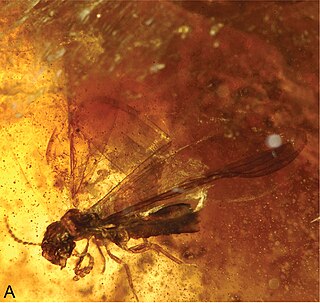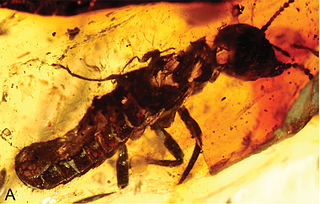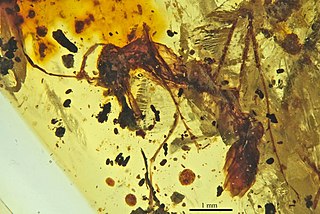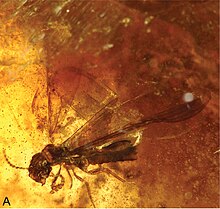
Mastotermitidae is a family of termites with one sole living species, Mastotermes darwiniensis which is found only in northern Australia. The remaining genera of this family are only known from the fossil record.

Termitidae is the largest family of termites consisting of 2,105 described species of which are commonly known as the higher termites. They are evolutionarily the most specialised termite group, with their highly compartmentalized hindgut lacking the flagellated protozoans common to "lower termites", which are instead replaced by bacteria and archaea. Whereas lower termites are restricted mostly to woody tissue, higher termites have diverse diets consisting of wood, grass, leaf litter, fungi, lichen, faeces, humus and soil. Around 60% of species rely on soil-feeding alone.

Deinodryinus areolatus is an extinct species of Deinodryinus in the wasp family Dryinidae. The species is solely known from an Eocene fossil found in the Baltic region.

Astreptolabis is an extinct genus of earwig in the Dermaptera family Pygidicranidae known from a group of Cretaceous fossils found in Myanmar. The genus contains two described species, Astreptolabis ethirosomatia and Astreptolabis laevis and is the sole member of the subfamily Astreptolabidinae.

Prostylotermes is an extinct genus of termite in the isopteran family Stylotermitidae known from two Eocene fossils found in India. The genus contains a single described species, Prostylotermes kamboja.
Zophotermes is an extinct genus of termite in the Isoptera family Rhinotermitidae known from two Eocene fossils found in India. The genus contains a single described species, Zophotermes ashoki placed in the subfamily Prorhinotermitinae.

Parastylotermes is an extinct genus of termite in the Isoptera family Stylotermitidae known from North America, Europe, and India. The genus contains five described species, Parastylotermes calico, Parastylotermes frazieri, Parastylotermes krishnai, Parastylotermes robustus, and Parastylotermes washingtonensis.

Mastotermes is a genus of termites. The sole living species is Mastotermes darwiniensis, found only in northern Australia. A number of extinct taxa are known from fossils. It is a very peculiar insect, the most primitive termite alive. As such, it shows notable similarities to cockroaches in the family Cryptocercidae, the termites' closest relatives. These similarities include the anal lobe of the wing and the laying of eggs in bunches, rather than singly. The termites were traditionally placed in the Exopterygota, but such an indiscriminate treatment makes that group a paraphyletic grade of basal neopterans. Thus, the cockroaches, termites and their relatives are nowadays placed in a clade called Dictyoptera.
Mastotermes electromexicus is an extinct species of termite in the family Mastotermitidae known from a group of Late Oligocene to Early Miocene fossils found in Mexico. M. electromexicus is the only species in the genus Mastotermes to have been described from fossils found in Mexican amber and was the first member of the genus described from the New World. The only living species of Mastotermes is Mastotermes darwiniensis which is found in tropical regions of Northern Australia.
Termitaradus dominicanus is an extinct species of termite bug in the family Termitaphididae known from a Miocene fossil found on Hispaniola. T. dominicanus is the third species in the genus Termitaradus to have been described from fossils found in Dominican amber after Termitaradus avitinquilinus and Termitaradus mitnicki.
Termitaradus avitinquilinus is an extinct species of termite bug in the family Termitaphididae known from several possibly Miocene fossils found in the Dominican Republic. T. avitinquilinus is the first species in the genus Termitaradus to have been described from fossils found in Dominican amber and is one of four species from New World amber, the others being Termitaradus protera, Termitaradus dominicanus and Termitaradus mitnicki.

Electrostephanus is an extinct genus of crown wasp in the hymenopteran family Stephanidae, and is the only genus placed in the subfamily Electrostephaninae. The genus contains four described species, E. brevicornis, E. neovenatus, E. janzeni, and E. petiolatus, placed in two subgenera E. (Electrostephanus) and E. (Electrostephanodes). Electrostephanus is known from several middle Eocene fossils which have been found in Europe.
Zigrasolabis is an extinct genus of earwig in the family Labiduridae known from Cretaceous fossils found in Myanmar. The genus contains a single described species, Zigrasolabis speciosa.
Toxolabis is an extinct genus of earwig in the dermapteran family Anisolabididae known from a Cretaceous fossil found in Burma. The genus contains a single described species, Toxolabis zigrasi.
Feroseta is an extinct genus of mantidfly in the neuropteran family Mantispidae known from a fossil found in North America, and which contains a single species, Feroseta prisca.

Myanmyrma is an extinct genus of ants not placed into any Formicidae subfamily. Fossils of the single known species, Myanmyrma gracilis, are known from the Middle Cretaceous of Asia. The genus is one of several ants described from Middle Cretaceous ambers of Myanmar.
Cananeuretus is an extinct genus of ant in the Formicidae subfamily Aneuretinae, and is one of two Cretaceous genera of the subfamily. The genus contains a single described species Cananeuretus occidentalis and is known from one Late Cretaceous fossil which has been found in North America.

Camelomecia is an extinct genus of stem-group ants not placed into any Formicidae subfamily and probably not into Formicidae itself. Fossils of the single known species, Camelomecia janovitzi, are known from the Middle Cretaceous of Asia. The genus is one of several ants described from Middle Cretaceous ambers of Myanmar.

The Cubitermitinae are an Afrotropical subfamily of higher termites with 28 known genera and 147 species. The nests of most taxa are either subterranean or found within the mounds of other termite species. The most well known genus of this subfamily is Cubitermes, which commonly build epigeal nests with one or more caps used to shield the nest against rainfall, giving them a characteristic mushroom shape. Most members of this subfamily are soil-feeders.
The Cambay Shale Formation is an Early Eocene-aged geologic formation in the Cambay Basin, India. It varies in thickness from a few meters on the margins of the basin to more than 2,500m in the depressions. It directly overlies the Olpad Formation and is, in turn, overlain by the Anklesvar Formation in the southern part of the basin and by Kalol Formation in the northern part of the basin. Further north, the Cambay Shale, in its lower part, is gradually replaced by tongues of paralic-deltaic Kadi Formation and finally by Tharad Formation.











